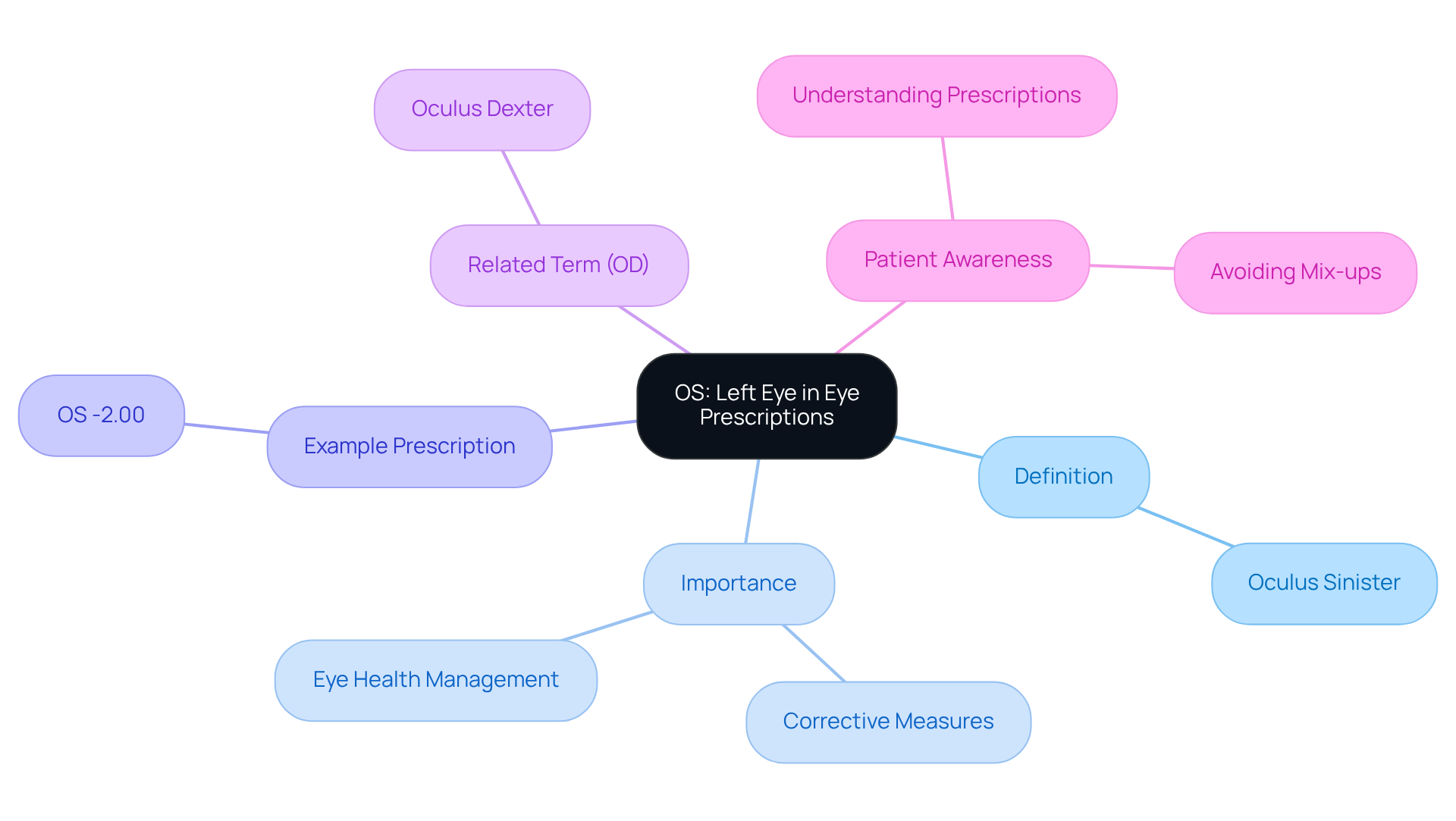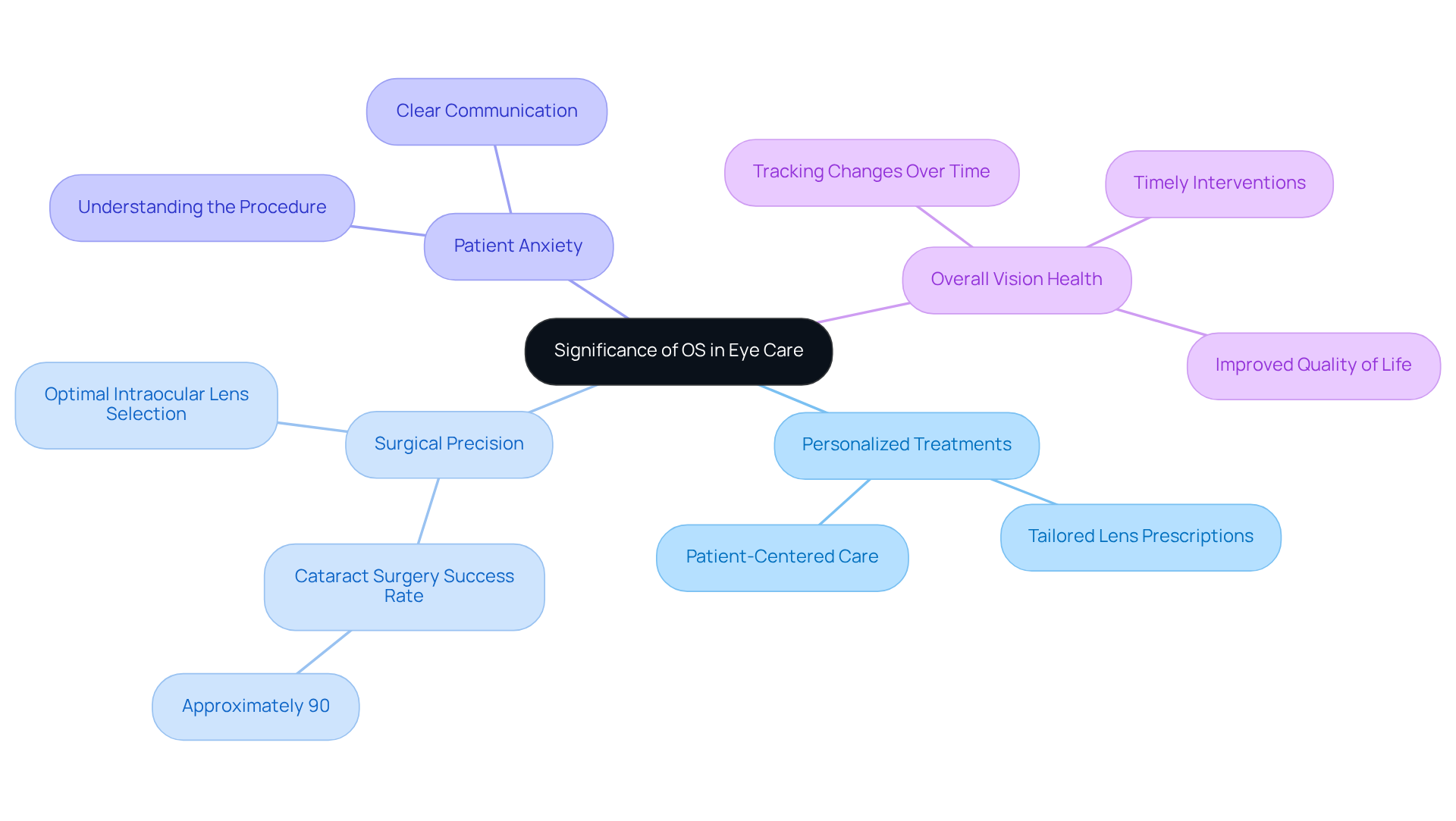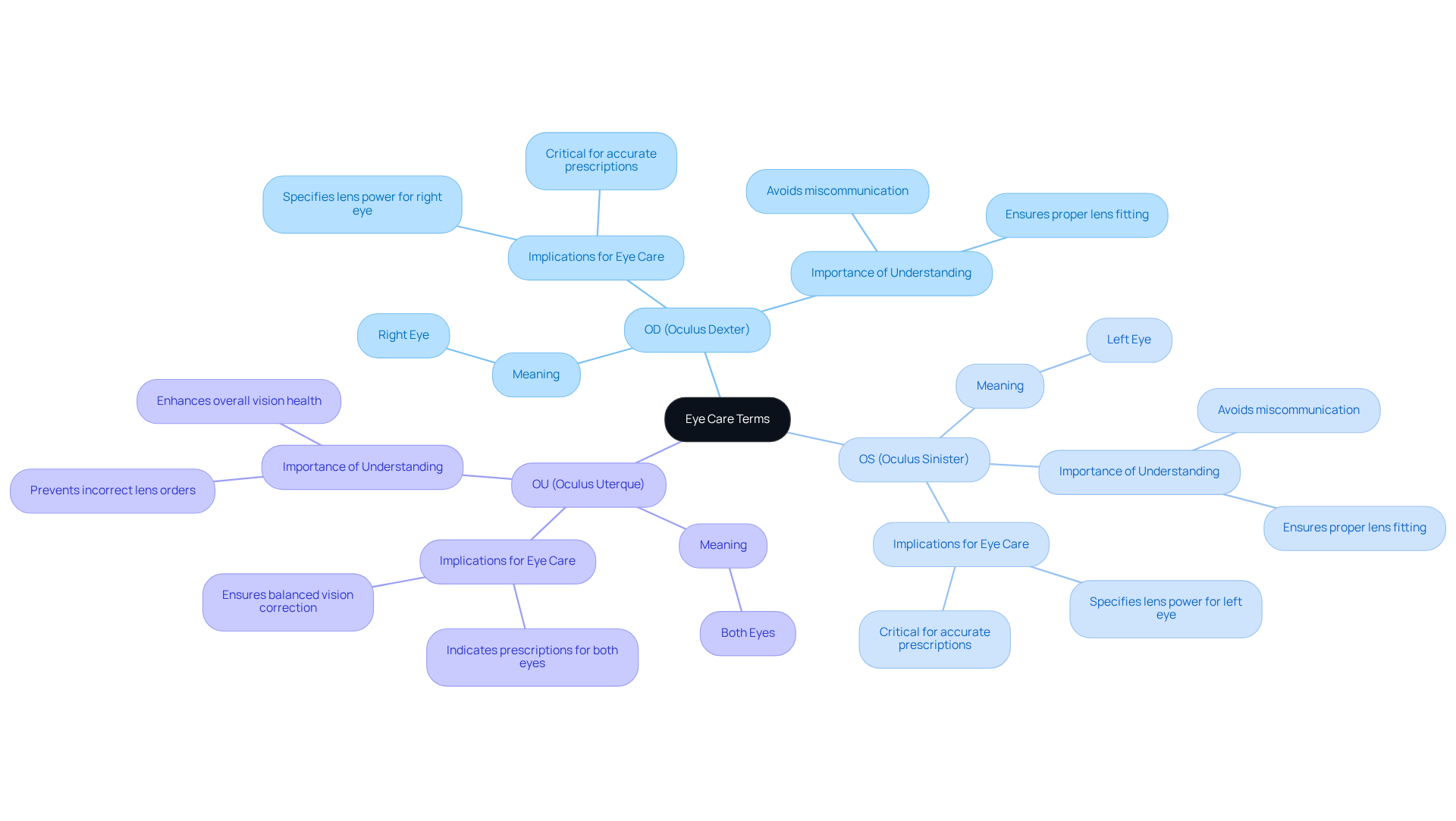Posted by: Northwest Eye in General on August 8, 2025
Overview
In eye care, the term “OS” stands for “oculus sinister,” which identifies the left eye. This understanding is vital for ensuring that prescriptions and treatments are accurately tailored to meet your unique vision needs.
We understand that navigating eye care can be overwhelming, and it’s common to have questions about terminology. By grasping this important concept, you can help prevent mix-ups in your care. This knowledge not only enhances treatment outcomes but also fosters effective communication between you and your eye care professionals.
We are here to help you through this process, ensuring that you feel supported and informed every step of the way.
Introduction
Understanding the intricacies of eye care can often feel daunting. We recognize that the medical jargon and abbreviations can be overwhelming. Among these terms, “OS” is particularly important; it designates the left eye on eye prescriptions. Grasping the meaning and implications of OS not only helps in creating personalized treatment plans but also empowers you to make informed decisions about your vision health.
However, it’s common to feel uncertain about what happens when this essential knowledge is overlooked. Misunderstandings surrounding OS, OD, and OU can lead to significant errors in vision correction. This highlights the pressing need for clarity in eye care communication. We are here to help you through this process, ensuring you feel supported and informed every step of the way.
Define OS: The Left Eye in Eye Prescriptions
The term comes from the abbreviation ‘oculus sinister,’ which translates from Latin to ‘left eye.’ This term is a standard element of eye evaluations, which relates to the os eye meaning by indicating the specific corrective measures required for .
We understand that navigating eye care can be overwhelming, but is vital for you, as it enables you to differentiate between orders for each eye. This understanding guarantees that you obtain the .
For instance, a prescription that reads ‘OS -2.00’ signifies that the left eye needs a lens with a power of -2.00 diopters to correct nearsightedness. This clarity is essential not only for but also for your overall .
Research indicates that a significant percentage of patients—approximately 36%—do not have the necessary . This underscores the importance of understanding these abbreviations. Expert opinions emphasize that knowing the ‘os eye meaning’ can prevent mix-ups with medications and treatments, ultimately enhancing your outcomes.
Lusine Badalian observes, “That’s why precision is very important when reading or completing documents that include these abbreviations.” Furthermore, ‘OD’ represents ‘oculus dexter,’ indicating the right eye, offering a complete context for understanding your eye requirements.
It’s common to feel uncertain about these terms, but every one to two years are advised to ensure that your lenses are current. This further emphasizes the significance of comprehending the ‘os eye meaning.’
Real-world instances demonstrate that individuals who are educated about their medications, including the significance of ‘OS,’ are better prepared to participate in their eye care choices, resulting in . We are here to help you through this process.

Significance of OS in Eye Care and Vision Health
The significance of the OS eye meaning in eye care extends far beyond mere terminology; it plays a vital role in ensuring that patients receive . We understand that identifying which eye requires correction can feel overwhelming, but this clarity allows eye care professionals to prescribe the right lenses or surgical interventions with confidence.
For example, in , knowing the exact prescription for each eye enables surgeons to select the optimal intraocular lens (IOL). This precision is crucial for achieving the best possible visual outcomes. It’s common to feel anxious about surgery, but rest assured that studies indicate cataract surgery has a . significantly contributes to this success by allowing us to track changes in sight over time.
This level of accuracy facilitates , ultimately leading to greater satisfaction and . Testimonials from individuals highlight that greatly enhance their confidence in treatment choices. As Dr. Goldstein wisely states, ‘ is not just a detail; it is a cornerstone of effective treatment planning that directly impacts .’ We are here to help you through this process, ensuring that your journey towards is as smooth and reassuring as possible.

Clarify Misconceptions: OS vs. OD and OU
In the field of , we understand that the , as well as the abbreviations OD and OU, can be confusing. play a significant role in understanding .
- OD, short for ‘oculus dexter,’ refers to the right eye.
- OS, meaning ‘oculus sinister,’ denotes the left eye.
- OU stands for ‘oculus uterque,’ meaning both eyes.
Recognizing these differences is crucial for individuals, as each term represents specific elements of their correction needs. For instance, a prescription that includes both allows for a , ensuring that each eye receives the appropriate care according to its unique requirements.
It’s common to feel uncertain when navigating these terms, and misunderstandings can lead to incorrect lens orders or treatment plans. Such errors may result in insufficient sight correction, impacting daily activities and overall quality of life. Eye care specialists emphasize the importance of clear communication regarding these abbreviations to prevent misconceptions and ensure effective eye care. Dr. Steven Liem, an optometrist, highlights, ” can detect sight issues, prescribe corrective measures, and ensure you’re seeing the world as clearly as possible.”
For example, an individual who misreads their medication might overlook the need for different lens strengths for each eye, potentially worsening eyesight problems. The American Optometric Association recommends that individuals over age 65 have an . This highlights the importance of regular check-ups in clarifying these terms and reinforcing the significance of understanding one’s prescription.
By fostering patient education and awareness, eye care providers can enhance treatment outcomes and promote better vision health. We are here to help you through this process, ensuring you have the .

Conclusion
Understanding the OS eye meaning is essential for anyone navigating the complexities of eye care and vision health. We understand that grasping this terminology, which signifies the left eye, can feel overwhelming. However, by familiarizing yourself with it, you can ensure that you receive the correct prescriptions and treatments tailored to your specific needs. This knowledge not only aids in effective vision correction but also plays a crucial role in overall eye health management.
The article highlights key insights, such as the importance of accurate documentation in prescriptions and the implications of misinterpreting terms like OS, OD, and OU. It’s common to feel confused about these abbreviations, yet understanding them is vital to prevent errors that can adversely affect your quality of life. Regular eye check-ups are also necessary, as a significant percentage of patients lack the appropriate corrective lenses. Clear communication and education about these terms empower you to make informed decisions regarding your eye care.
Ultimately, fostering a deeper understanding of the OS eye meaning can lead to better treatment outcomes and enhanced vision health. Eye care providers and patients alike must prioritize clarity in communication to ensure that everyone receives the care they need. By embracing this knowledge, you can take proactive steps toward maintaining your vision and overall eye health, reinforcing the idea that informed patients are empowered patients.
Frequently Asked Questions
What does OS mean in eye prescriptions?
OS stands for ‘oculus sinister,’ which is Latin for ‘left eye.’ It indicates the specific corrective measures required for the left eye in eye evaluations.
Why is understanding the OS eye meaning important?
Understanding the OS eye meaning is vital as it helps differentiate between the prescriptions for each eye, ensuring that you receive the appropriate lenses or treatments for optimal vision correction and eye health management.
What does a prescription reading ‘OS -2.00’ signify?
A prescription that reads ‘OS -2.00’ means that the left eye requires a lens with a power of -2.00 diopters to correct nearsightedness.
What percentage of patients lack the necessary corrective lenses?
Approximately 36% of patients do not have the necessary corrective lenses, highlighting the importance of understanding eye prescription abbreviations.
What does OD represent in eye prescriptions?
OD stands for ‘oculus dexter,’ which means ‘right eye.’ It provides context for understanding the requirements for both eyes.
How often should one have routine eye check-ups?
Routine eye check-ups are advised every one to two years to ensure that your lenses are current and to maintain overall eye health.
How does being educated about medications and prescriptions impact eye care?
Individuals who are knowledgeable about their medications, including the significance of terms like ‘OS,’ are better prepared to participate in their eye care choices, leading to improved eye health outcomes.






